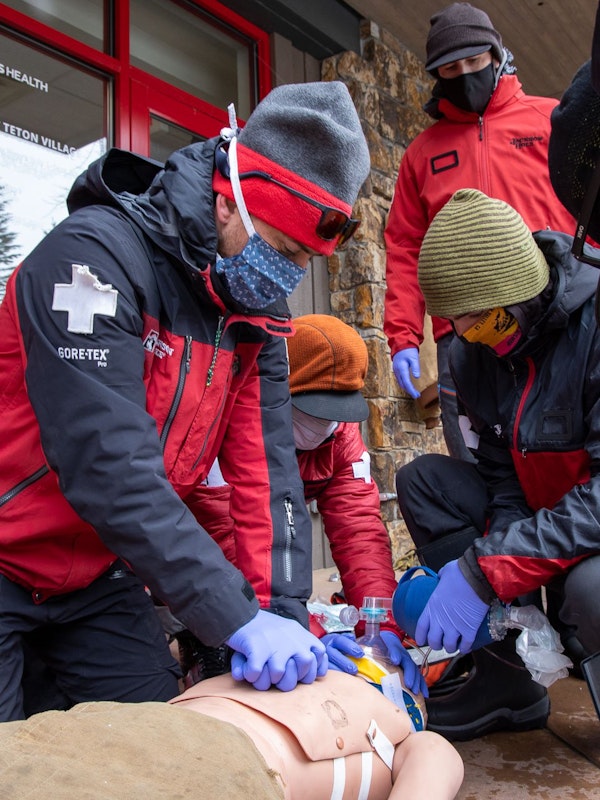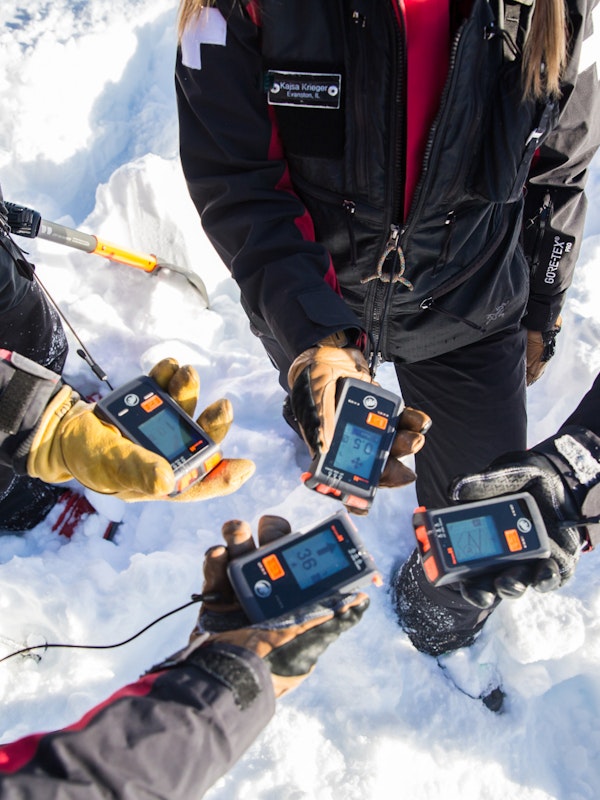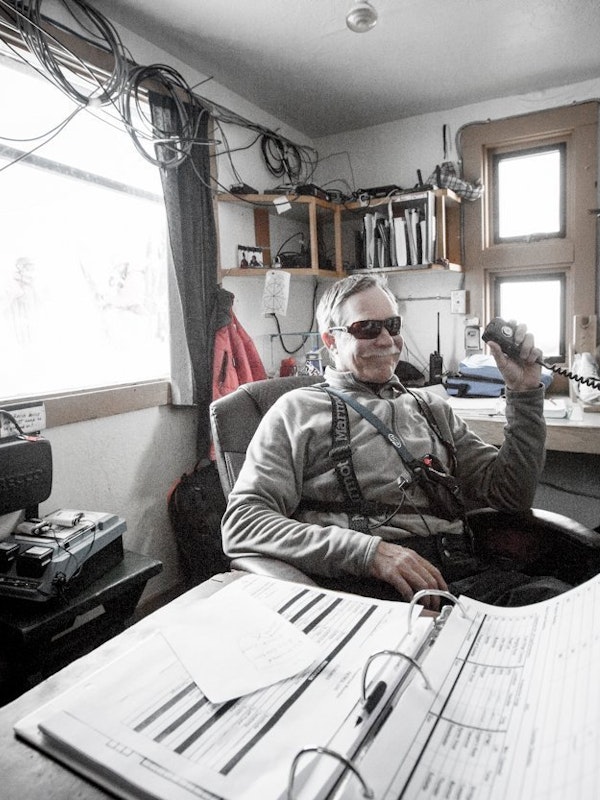In mountain towns across the country there are stories of legends, past and present, that run through the peaks and valleys of the community. These people inspire the lives of many and create a lasting impact on the local culture. Tom Raymer of the Jackson Hole Ski Patrol was one of those people and Stio’s Raymer jacket is named to honor his legacy. Join us in supporting the Raymer family and the Jackson Hole Ski Patrol by contributing to the Jackson Hole Ski Patrol Memorial Scholarship Fund at - https://jhspmemorialfund.org/
Words by Jeff Burke
I never knew Tom Raymer, but I hear his name every day. I work winters for the Jackson Hole Ski Patrol, and each morning during our meeting we are enjoined to hear the snow and wind forecast from the Raymer snow study plot, a staple of our job. One of our primary weather data collecting sites, it lives at 9300 feet, a short hike above what is now the summit of the Bridger Gondola and gateway into Casper Bowl and Ranger Point. And, like Tom Raymer’s spirit, is still one of the most untamed places at Jackson Hole Mountain Resort.
Tom Raymer was like many east coast transplants looking for glory in the snowy mountains of Wyoming. Born in Annapolis, Maryland, in 1948, he was the son of a Navy man. He and his older sister Susan were subject to their father’s itinerant career, living in Key West, Norfolk, Boston and Newport while growing up. Tom learned to ski in the White Mountains of New Hampshire, where he got the bug to schuss down wind-swept slopes, and even worked in a ski shop as a kid in the DC area. After graduating high school, he met his father’s wishes by enlisting in the US Coast Guard, to satisfy his public service. But once he finished, Raymer did what any 20-year-old who longed for the mountain life would do. He borrowed eleven dollars from his mother, went to the local police auction, bought a three-speed bicycle for five bucks, and rode it from Virginia to Wyoming. In November.
“It was the farthest place from the ocean he could find,” says his niece Meilani Schijvins, who, along with her sister Jocelyn, spent much time with Uncle Tommy in Wyoming when they were teenagers.
That transcontinental ride is a less-than-subtle introduction into his self-imposed austerity and resilience, the twin pillars of his larger-than-life character. In the early 70s, Tommy Raymer would “live” at what was called the Halfway House, a small shack beside the base of the Thunder Chairlift at Jackson Hole Mountain Resort. Equidistant from the valley floor and the summit of Rendezvous Mountain, Raymer’s home was approximately 2000 vertical feet up the mountain. “He would walk up there every night in the summer to sleep,” says Margo Krisjansons, a close girlfriend, and long-time colleague on the Jackson Hole Ski Patrol.
On days off he would meet partners at the base of the Tram to go climbing in Grand Teton National Park. Doug Ward, who served out his draft service during the Vietnam War on a base in Germany, (“I was lucky”, he says) originally met Tom at the famous Stagecoach Bar in Wilson in 1972. Ward, who is the brother to long-time patrol director Corky Ward, became fast friends with Raymer, and formed a tight climbing partnership. One evening they made plans to climb in the Park the following day. That morning Doug noticed something out of the ordinary. “I remember seeing his pack beside the Tram,” he says, “but no Tom.” Tom wasn’t the kind of person to be late. He waited a few minutes, and noticed Raymer jogging into view down the game trail from above. “I forgot to feed the cats,” he says.
One of Raymer’s more lasting sobriquets was ‘Ranger’, but to many of his earlier associates, he was Tommy Terrific, a preternatural athlete who was the inaugural winner of the valley’s “Pole, Pedal, Paddle” race every spring. The brainchild of Harry Baxter, the PPP as it’s known, is part Downhill Super G, part skate ski, part road bike, and part boat/kayak. The race starts atop Jackson Hole Mountain Resort, and ends half a day down the valley at the Astoria Hot Springs’ boat ramp. Competitors are usually comprised of teams, who each take a leg of the race. Some do perform the whole race solo, as did Raymer, who ended up taking First Place two years in a row. It is believed he bested the competition by not swapping out skate ski boots for cycling shoes during the road bike leg. Fair enough.
Raymer drew a paycheck in the summers from Jackson Hole Mountain Guides. In 1976, he was leading a client off the Grand Teton when they took a fall during a descent. “He saved his client and himself,” remembers Krisjansons. And in catching the fall Raymer injured both his legs very badly. “He broke his femur in one leg, and blew his ankle apart in the other,” she says.
Renny Jackson and John Carr, both newly christened Grand Teton Climbing Rangers at the time, were a part of the rescue efforts. The weather that day was unstable, remembers Jackson, preventing any chance at a helicopter rescue. “It was stormy enough that we couldn’t even pick him up at the Saddle,” he says. The Lower Saddle is the divide between the Grand and Middle Teton, a high alpine camping spot shared by climbing rangers, guides and private parties. Because his injuries were serious enough to warrant an immediate evacuation, they loaded him into a litter above the Saddle, and several rescuers carried him over seven miles down trail, snow and rock, using additional rope lowers where necessary, to the Lupine Meadows Trailhead, spending much of the time under darkness before arriving at the valley floor the following morning. “He had to take numerous years to heal, and one leg had to be shortened,” says Krisjansons. “It was way back in the day before all the fancy surgeries.”
After the accident, Raymer still thrived in the skiing environment, and he was no less a superstar on the ski patrol, according to John Carr, who worked alongside Raymer for many years. Big smile, quiet and curious, he was known to be a prodigious worker among his peers, never shying away from a difficult task. His favorite saying was “no danger”. “He didn’t talk much,” says Carr, “but he nodded a lot. He was also the hardest worker too. He made us all look bad.”
“He was just completely dedicated to the job,” adds Jackson, who also worked on ski patrol with Raymer from 1980 to 1986. On some nights during the winter, the patrol room might see a couple workers who drank too much and spent the night. “It didn’t matter how early the next day came,” he says, “he’d have already been there, made coffee, cleaned the room, boots on and ready to go.” It’s worth mentioning that Raymer’s commute to work was made possible by the fact he lived in an igloo beside Eagle’s Rest Chairlift one winter, to which his aforementioned climbing partner Doug Ward was a houseguest from time to time.
Melissa Malm and, shortly thereafter, Krisjansons, became the first two women to work on JHSP, an intimidating position regarding the type of job and time in western Wyoming mountain culture. To call it male dominated is nothing shy of understatement. Yet, Malm and Krisjansons flourished. “Tom was always there to show us how he did things,” says Krisjansons, “because he wasn’t very tall either. But he was super strong and gave us all the support and encouragement, and told us how stoked he was that we got hired.”
The first two decades of avalanche control work at the Jackson Hole Mountain Resort were raw and rife with men and artillery versus Mother Nature, much of which was conducted by professional Snow Rangers and former ski patrolman with previous experience. It’s not that the attitude was cavalier as much as they merely participated in the inchoate world of avalanche reduction, and formed a burgeoning understanding of the dynamic relationship between weather, terrain, and snowpack on a scale never before realized in North America. On-the-job education was prevalent across the US, and so far, the Jackson Hole Ski Patrol had a safe record.
Paul Rice worked on the patrol for eighteen seasons over twenty years, and he remembers the day Tommy Raymer died. A prolonged storm had taken the Tetons hostage in February of 1986. “It was still loading and snowing,” he says. “The ski area was closed to the public, and all we were trying to do was protect the lifts as I recall.” Rice, John “Bernie” Bernadyn, and Raymer went up to the Casper area. “The 105 (Howitzer Canon) had been shot with what we now call 'Tommy’s Slide ridge shot'. We went out on the slope, put another ’boo shot (air blast above the snow surface) on it, retreated and it went off. Nothing.”
It wasn’t a known slide area, but since it was such a historic snow event, with slides going off the Lower Faces and the Hobacks, nothing was off limits. After the blast, the three spread out over the slope to surmise the situation. Rice thinks the slide was from a point on the ridge above them where it collapsed and gathered steam.
“There was no noise, no sound,” says Rice. “I glanced over and just saw the wall of snow coming down. I was only maybe fifty feet from Tommy, and the slide missed me by fifteen feet, I’m guessing.”
“I yelled at Tommy, and he was actually in a pretty good spot. And he pushed off. It was just a reflex to yell. What do you do? If he’d stayed put, maybe, it would’ve gone over him. But he was a great athlete with amazing reflexes… Then he disappeared under the cloud of snow.”
Sad as this was, Raymer’s death was not the first of that winter season. On Dec. 2nd, of 1985, his co-worker Paul Driscoll, a native New Yorker and US army Lieutenant, (who passed on a law career despite passing the Wyoming Bar) died in an avalanche on Dean’s Slide in the Jackson Hole Mountain Resort. “Paul’s death really took Tommy down hard,” says Krisjansons. “Like he took it personally. He got pretty quiet after that.
With Paul Driscoll’s death, the first on-the-job fatality sustained by JHSP, the event wiped away the superficial gloss of cheating death, saving lives and blowing shit up, and placed a period on the seriousness of ski patrolling in the big mountains. Yes, it’s exciting, risky, and it’s got sex appeal, but you can also lose your life doing this job.
“And when Tommy died,” says Krisjansons, “it was the absolute worst. It had us all traumatized.”
Like any professional career with consequence, there is still a job to do, and JHSP rode out the winter supporting one another. “Patrol stuck together,” says Krisjansons, “and we finished out the year. I actually got a little depressed when ski patrol ended, because all of a sudden you’re not with your buddies any more. Everyone separates after the season, and goes their own way. It was just so much losing two guys in avalanches.”
With any close-knit community, painful experiences can momentarily crush our collective spirit, and often leave us desperate and lethargic. “The world breaks everyone,” reminds Hemingway, “and afterward many are strong at the broken places.”
“All the people who were working those years,” says Krisjansons, “we’ve been like a bonded family. There’s been very close camaraderie between all of us since that year.”
In tracking down stories of Tom Raymer, all my sources kept telling me to talk to this person, that person—the list of characters and storylines would make a Netflix series. Tales of near misses, forbidden love, heroic feats, twisted humor—the very fuel that fills a world burning with vitality and meaning.
After Tom’s death, his friends finished his rustic cabin on the Teton Village Road, and his family has kept the house to this day. For years his parents kept close ties with the Jackson Hole Ski Patrol, and have given them all but unfettered access, for family and friends of the patrol. “His parents were so gracious,” says Krisjansons. “They said, ‘we want to stay connected to the ski patrol people.’ So they came out every year to visit and got very close. ‘We want to share this house with ski patrol families and exchanges.’ And it’s that spirit,” maintains Krisjansons, “that must’ve been where he got it. Because his parents were so generous.”
Tom was one of many characters who emigrated to the Tetons from the distant corners of the US in search of some fulfillment. His Spartan lifestyle and creative mind live on in the memories of friends and loved ones he left behind. One could argue that 37 is a troubling age to get caught in the crosshairs of life and death. You’ve lived long enough to hopefully know who you are, so that by the second half of your life, if you’re lucky to live it, will matter. “People said it was sad that he died at such a young age,” says niece Meilani, “but I’m pretty sure he lived all nine lives to the fullest.”
-----
The Jackson Hole Ski Patrol Memorial Scholarship Fund is dedicated to providing college scholarships to high school students whose spirit and love of mountain adventure honors the memory of ski patrollers no longer with us. To support the Raymer family and the Jackson Hole Ski Patrol donations can be made at - https://jhspmemorialfund.org/
Jeff Burke is a freelance writer living in Jackson, Wyoming. He has been working on the Jackson Hole Ski Patrol for fourteen years keeping skiers safe in our community.
From The Blog

Threading Needles - JHSP Brings Skier Back to Life
How long does forever last? For Peggy Hays, a visiting skier to Jackson Hole Mountain Resort, forever lasted about 15 minutes on March 1st, 2020—the moment her husband dropped on the slope to the second in which he left the scene in a rescue sled with scarcely a pulse. The call came into Ski Patrol […]

Avalanche Safety with Jackson Hole Ski Patrol
Trusted by the Jackson Hole Ski Patrol (JHSP) and professionals worldwide, the Mammut Barryvox S is the best in class avalanche transceiver.

The Unsung Heroes
Just like that the season is wrapping up in just 4 days. When we look back the memories once again are epic. From getting married at the top of Rendezvous Peak to many powder days, we are once again grateful for our season here. With only a couple blog posts left in the season there […]